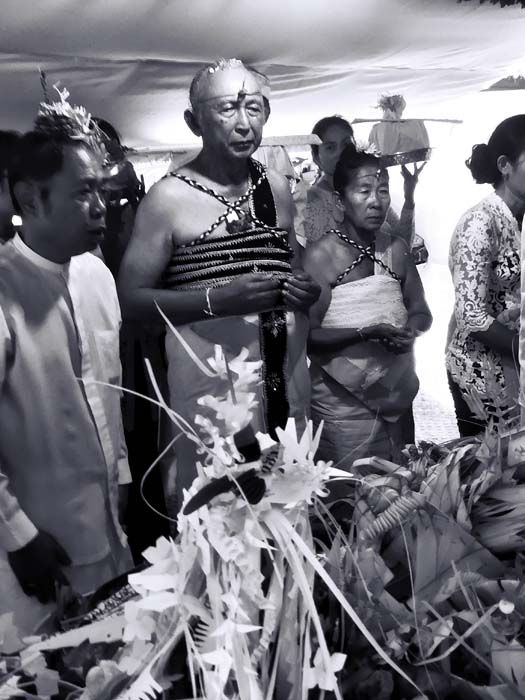Will it eventually be like Hindu India, where the Brahmans now rule the roost and control the land deals; the ksatria having disappeared up their collective bottoms and down their perfume bottles decades ago?

So many princely houses have folded lately — sold due to gambling debts, or just deserted under the weight of the combined ceremonial responsibility — that one starts to worry for the future of feudalism. The great palaces of Gianyar, Sukawati, Karangasem and Mengwi are all but empty: their liege lords having chosen to live in the Civic Centre district (Renon) so that they can be nearer Pizza Hut and away from the constant demands of their braying subjects.
Meanwhile, the Brahman houses are thriving. There are more Brahman priests (pedanda) on Bali than ever before and a new sect — the glambram (Brahmana-glamourd an elite division of hotel-owning, Jaguar-driving Brahmans — is consolidating.
Will it eventually be like Hindu India, where the Brahmans now rule the roost and control the land deals; the ksatria having disappeared up their collective bottoms and down their perfume bottles decades ago?
The great Brahmana-kuasa villages of Bali — Sanur, Munggu, Buda Keling, Banjar, Kesiman, Mas, Manuaba, Tegal (Denpasar), Bajra, Sidemen, Kesiman (Denpasar), Kamasan (Klungkung) — are infinitely happier than ones controlled by the princely families, with their constant bickering over Tahta Harta Wanita (Throne, Wealth, Women).
Last month I went to the pediksaan (priest ordination) of the ex- head of the P.D.I. political party in Gianyar — a dashing, tall Brahman I have seen on the ceremonial circuit over the years. The ceremony was immaculate: during the climax of the weeks of ritual, the novices have to ceremonially ‘die’ and be brought back to life with a kick to the head by their Nabe/guru.
The atmosphere in the Geria Sedawa in Gianyar was magical — all the palace ladies were fluttering about with offerings and special tantric power object and such.
The courtyards were packed to the gills with representatives from all the major brahmana houses in the regency. On the high pavilion sat the Mayor of Gianyar A.A. Gde Agung Baratha, the local prince, and Cokorda Pemecutan XI, my big love, whose son-in law’s uncle was being ordained. The princes roared and joked (about recent conquests) while the gathered brahmans sat pretty, doing real estate deals.

At one point, I escaped the fashion show-cum-ordination and visited the 12th century temple next door, which has a 500 year old inscribed lontar palm book the Tatwa Dwijendra, telling of the visit to the temple of Dang Hyang Dwijendra Pedanda Sakti Wawu Rauh in the 16th Century. The temple, Pura Tugu, is a classic example of Majapahit-Bali architecture. Dwijendra is the great ancestor of nearly all of the present-day Brahmans (only the Buda Keling Brahmans are descended from Dang Hyang Astapaka, Dwijendra’s cousin).
By chance, last month also, I visited the home town in Java, near Kediri, from whence the brahmana Bali originate. There, in a temple dedicated to Empu Baradah, was a family tree showing how all of Java and Bali’s high priests are descended from three Indian Brahmans who came to Java in the 9th century.
No ksatria family can trace their line back that far.
22 September 2015: To Sanur for 6 month (otonan) ceremony of my gorgeous niece Dayu Mas’ daughter.
Last year, my favourite niece from my adopted Balinese family married a Sanur brahmana — a sweet skinny lad from a major Brahman house.
It was considered something of a coup as our little geria (Brahman house) — an offshoot of the Brahmana Manuaba palaces of Bajing and Sidemen — is small fry compared to the great Brahman houses of Sanur, which all own at least one petrol station and whose women-folk carry designer hand bags.
The high priests officiating were like Mr and Mrs Santa, beaming good will as the tiny tot had her hair cut, ceremonially, and bangles put on.
The Balinese Brahmans have an expression, “Jaga Kulit” (noblesse du pêche), which relates to their specialness, being born Brahman.
The rites de passage of young Brahmans are therefore especially joyous, and quasi-sacred affairs with extra care being taken by the officiating priests to ensure that the young child is properly covered with spiritual insurance.









